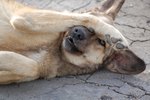
Unlike many other mammals, rats don't lose their first set of teeth. Instead, your rat will keep his original choppers and they will continue to grow throughout his life. Your rat will need proper food and care to keep his teeth from becoming overgrown and prevent the health problems that occur with this common problem.
Causes
Your rat's front teeth, known as the incisors, can grown up to 5 inches each year, according to the Canadian Federation of Humane Societies. Constant gnawing usually helps your pet to wear his teeth down to the right size. However, a genetic or environmental problem can prevent the teeth from wearing and create health issues for your pet. If he is born with a malocclusion, his jaws do not align and his teeth won't meet correctly, allowing the teeth to grow unimpeded. If your rat has chipped a tooth on the bottom, yet his top teeth are normal, the opposing teeth won't grow at the same rate. This can cause problems with his bite and interfere with natural wearing. In addition, if your pet doesn't have access to hard objects to chew, or eats a soft diet, his teeth may not wear down sufficiently.
Complications
When a rat's teeth are overgrown, he can't eat properly. In the worst scenario, your tiny friend can become malnourished and could even die. Also, if a tooth is allowed to become unnaturally long, it may grow at odd angles and dig into the inner lip or side of the mouth, causing a wound, or even infection. If your rat appears to be losing weight, visit your vet immediately.
Prevention
Overgrown incisors can often be prevented if your pet has the opportunity to chew hard materials, according to the ASPCA. Feed him hard rat pellets and provide plenty of toys to gnaw on. Blocks of wood that have not been chemically treated or painted make perfect chew toys. Dog biscuits, rawhide toys and bones will also help wear his teeth to a manageable length. Take careful note of your rat's appearance and habits. If you know how his teeth and mouth usually look, you will be aware if his incisors become too long, or his cheeks seem unnaturally swollen.
Treatment
If your rat's choppers don't wear down on their own, your vet can trim them every four weeks or so to keep them a healthy size. A dental tool called a bur can be used to whittle down your rat's teeth, but he may need to be anesthetized for the procedure. Severely deformed or troublesome teeth can be removed. Check with your vet about appropriate treatment options for your pet.
References
- National Center for Biotechnology Information: Malocclusion in Aging Wistar Rats
- Rat Behavior: Rat Teeth
- The Humane Society of the United States: Rat Feeding
- Canadian Federation of Humane Societies: Pet Mice and Rats
- Canadian Federation of Humane Societies: Mice and Rats
- Rats: Everything About Purchase, Care, Nutrition, Handling, and Behavior; Carol Himsel Daly
- ASPCA: Rat Care
Photo Credits
-
Comstock/Comstock/Getty Images
Writer Bio
Based in Los Angeles, Mary Helen Berg has been writing about pets, travel, families and parenting since 1989. Her work has appeared in publications such as "The Los Angeles Times" and "Newsweek." Berg holds a Master of Science from the Columbia University Graduate School of Journalism.




